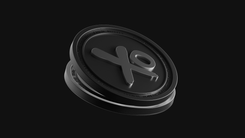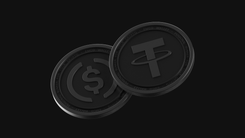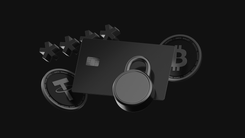How to Mine Canxium

Cryptocurrencies attract investors with their anonymity, decentralization, and the potential to earn profits from small investments. They operate based on distributed computing, performed by miners—individuals who own the hardware that supports the network.
Mining generates new blocks, validates transactions, and provides rewards in the form of newly minted coins and a part of transaction fees. This makes it a popular method of earning money on cryptocurrencies.
However, mining major cryptocurrencies like Bitcoin and Ethereum requires expensive equipment and consumes a significant amount of energy. As a result, mining newer cryptocurrencies is becoming increasingly attractive. It is often easier, more affordable, and more accessible for beginners.
In this article, we will explore the key features of the Canxium coin and explain what you need to mine it successfully. The EMCD platform can help you start earning from cryptocurrency mining today.
Contents:
- What Is Canxium and What Makes It Unique
- Why Canxium Mining Is Gaining Popularity
- What Equipment Do You Need to Mine Canxium
- Installing and Configuring Software for CAU Mining
- Best Pools for Mining Canxium
- CAU Mining Profitability and Key Factors That Affect Earnings
- Common Issues and Challenges in Mining Canxium
- Storing and Withdrawing Mined CAU
- Canxium’s Prospects and Its Role in the Future of Mining
- FAQ
What Is Canxium and What Makes It Unique
Canxium (CAU) is a decentralized cryptocurrency created by an anonymous developer known as Neo Krypt. It was launched in March 2023 through a “fair launch” mechanism. The coin had no ICO and no pre-mining by the developers—every miner began on equal terms. CAU stands out from other altcoins due to several key features:
- Dynamic emission model based on Proof of Demand (PoD). Unlike most cryptocurrencies that follow a fixed emission schedule, CAU employs a dynamic reward model. Block rewards fluctuate in response to overall market demand. When buy orders increase, block rewards adjust upward, attracting more miners and leading to increased block generation. When demand falls, fees decrease, some miners switch to other coins, and CAU supply drops along with demand. This helps limit inflation and keeps the coin’s price relatively stable. However, Canxium is not a true stablecoin—it’s not pegged to fiat currencies or other cryptocurrencies, nor does it use token-burning mechanisms to control supply
- Hybrid blockchain. The Canxium network integrates all three major consensus mechanisms: Proof of Work (PoW), Proof of Stake (PoS), and Proof of Demand (PoD). New blocks are mined using traditional PoW. The reward size is dynamically adjusted via PoD. Transactions are validated by stakers through PoS consensus. However, stakers do not receive rewards for this service. This combination ensures fair rewards for miners, helps maintain price stability, and reduces the risk of large holders dominating the network
- Offline mining via Retained Proof of Work (RPoW). CAU can be mined without a constant internet connection. It’s enough to perform local computations and periodically upload results to the Canxium network
- Cross-mining with Kaspa. While mining CAU, miners can simultaneously generate KAS coins without lowering the hash rate of their equipment
- Support for multiple PoW algorithms. CAU is mainly mined using devices that support a modified version of the Ethash algorithm. However, with proper configuration, it can also be mined on Bitcoin ASICs using SHA-256. The best results are achieved when mining both CAU and KAS in parallel on devices supporting the kHeavyHash algorithm
- Fast transaction processing. The average confirmation time is just 6 seconds
Main goals of the project:
- Developing a technology platform for simple and reliable financial tools
- Promoting an energy-efficient and environmentally friendly mining model
- Providing a secure store of value
- Expanding mining access for beginners
In summary, Canxium is a relatively new coin with many benefits for miners and built-in mechanisms for maintaining price stability.
Why Canxium Mining Is Gaining Popularity
Mining Canxium is becoming increasingly popular, largely because its developers focused on creating favorable conditions for miners. Key advantages include:
- Stable mining costs – since there’s no fixed emission cap and block rewards automatically adjust based on mining difficulty, the cost of mining CAU remains relatively consistent over time
- Fair and balanced mining model – although transactions are validated using Proof of Stake, all rewards are issued through Proof of Work—putting all miners on equal footing
- Support for multiple hashing algorithms – there's no need to invest in exotic or specialized mining hardware—most existing equipment can be used with proper configuration
- Offline mining support – temporary loss of internet connection doesn’t affect profitability—mining data can be submitted once the connection is restored
- Cross-mining with Kaspa – the ability to mine two coins at once significantly increases earnings
- Proof of Demand model – block rewards increase when market demand for CAU rises, allowing miners to earn more during price surges
- Growth potential – although CAU trades around $0.32 in 2025, many experts expect its value to grow in the coming years
What Equipment Do You Need to Mine Canxium
As of 2025, it is still theoretically possible to mine Canxium using GPUs or even CPUs—just like many other popular cryptocurrencies. Since the Ethash algorithm is optimized for GPUs, direct Canxium mining works best on this type of hardware.
However, in practice, mining CAU on GPUs without cross-mining is generally unprofitable due to the coin’s relatively low price. That’s why the most efficient approach is to use ASICs—specialized devices designed for mining cryptocurrencies with specific algorithms.
Due to its multi-algorithm support, CAU mining is compatible with a broad spectrum of ASIC devices. The blockchain itself runs on Ethash, so Ethereum ASICs perform well. Mining is also possible on SHA-256 ASICs originally made for Bitcoin. But as of 2025, the highest profitability comes from kHeavyHash ASICs, which were built for mining Kaspa. With this setup, you can earn CAU rewards for every KAS block mined—significantly increasing profitability.
Experts recommend the following kHeavyHash ASICs, currently available on the market:
- Antminer KS7 (40 TH/s, 3,080 W, 77 J/TH) – a powerful, high-performance option for large-scale investors
- IceRiver KAS KS7 (30 TH/s, 3,500 W, 116 J/TH) – a more affordable model with solid performance
- Bitmain Antminer KS5 Pro (21 TH/s, 3,150 W, 150 J/TH) – a balanced ASIC for small and mid-sized farms
- IceRiver KAS KS7 Lite (4.2 TH/s, 500 W, 119 J/TH) – a budget-friendly choice for small home setups
- Direct mining on high-performance Ethash devices like the Jasminer X4-Q-Z (840 MH/s, 340 W, 0.4 J/MH) also yields good results.
In addition to ASICs, you’ll need the following to set up your mining farm:
- Voltage stabilizers and uninterruptible power supplies (UPS)
- A proper climate control system—a dry space with good ventilation is essential
- A PC with a stable internet connection for managing ASICs and monitoring performance
- A secure, hack-resistant router
For larger operations, it’s also a good idea to install a reliable alarm system and video surveillance.
Installing and Configuring Software for CAU Mining
For direct GPU mining of CAU without cross-mining, the most popular programs are HiveOS and T-Rex Miner. Both are available for Windows, Linux, and other major operating systems. To get started, follow these steps:
- Download the software from the official website
- Install the program on your device
- Locate the configuration file or .bat script inside the program folder
- Edit the config or script to include your chosen mining pool address and the wallet address where mining rewards should be sent. Many pools provide ready-made config files and scripts for convenience
- Launch the program and start mining CAU with your GPU
However, as of 2025, much higher profitability comes from cross-mining Kaspa and Canxium—especially using ASICs optimized for Kaspa.
Most modern ASICs designed for Kaspa—such as IceRiver KS0–KS7 and Bitmain Antminer KS3–KS7—come with pre-installed firmware optimized for the kHeavyHash algorithm. All you need to do is correctly enter the mining pool address and wallet addresses for both Kaspa and Canxium in the ASIC settings.
To manage multiple ASICs, you can use software like Awesome Miner or Minerstat ASIC Hub. Here’s how:
- Download the program from the official website and install it
- Run it on a PC that’s shares the local network with your ASICs
- Configure the connection to your ASIC devices
- Enter the pool addresses and wallet information for payouts
- Start mining
Best Pools for Mining Canxium
As of 2025, several major mining pools support cross-mining of KAS and CAU:
- EMCD
- 2Miners
- F2Pool
- gtpool
- PCPRAHA
Most of these pools offer pre-made configuration files and/or detailed setup guides to help users get started quickly. Among them, EMCD offers the most favorable conditions with a fee of just 1.5%.
CAU Mining Profitability and Key Factors That Affect Earnings
At the current price level of $0.32 per CAU in 2025, direct mining of this coin alone is not profitable. Using a GPU, it could take several months just to accumulate the minimum amount required for a payout. Even when mining with a relatively powerful ASIC delivering 20 TH/s, you would earn less than 0.05 CAU per week—equivalent to around $0.016 in weekly profit.
However, with cross-mining CAU and Kaspa, the numbers change significantly. That same ASIC can generate about 563 KAS per week in addition to the 0.05 CAU—equating to roughly $62 in weekly income.
Several key factors influence CAU mining profitability:
- CAU market price – with the Proof of Demand (PoD) model, this factor impacts earnings in two ways. When CAU price rises, you can sell coins for more, and the block reward also increases—boosting profitability further. But when the price drops, your income will fall sharply
- Electricity costs – the lower your power rates, the higher your net mining profit
- Proper hardware and software configuration – the CAU network is relatively new and includes several unique features. It does not work well with generic firmware or default settings
- Pool fees – higher fees reduce your overall profit
- Additional costs – for example, some mining software may charge usage fees
Importantly, due to the PoD mechanism, mining difficulty has less impact on profitability than in other coins.
Given current market conditions in 2025, the most effective strategy is cross-mining Kaspa and Canxium. KAS coins can be sold immediately to secure profit, while CAU tokens are better held in anticipation of future price growth.
Common Issues and Challenges in Mining Canxium
Mining Canxium (CAU) often involves challenges when setting up offline mining using Retained Proof of Work (RPoW). These problems frequently stem from hardware or software incompatibilities with Canxium’s unique network parameters. For example, outdated DAG files or incorrect time settings can cause improper block generation. Wallet synchronization and submitting mined blocks to the network can also be difficult, especially when mining in isolated environments without a stable constant internet connection.
Additional issues arise during cross-mining with other coins like Kaspa. Not all ASIC miners and mining software correctly allocate resources between algorithms, which may reduce overall efficiency. Canxium mining is also highly sensitive to overheating and unstable power supplies.
To maximize profits, it’s crucial to ensure proper ventilation and a stable power supply. Proper configuration of mining hardware and software is equally critical to maximize efficiency.
Storing and Withdrawing Mined CAU
You can use the official wallet available on Canxium’s GitHub to store CAU coins. Its main feature is support for offline signing, which is important for working with the RPoW algorithm. Other wallet options include:
- MetaMask – ideal if you plan to actively use CAU on dApp platforms. Note that the network must be configured manually with these settings: Network Name: Canxium, RPC URL: https://rpc.canxium.org, Chain ID: 3003, Symbol: CAU, Block explorer URL: https://explorer.canxium.org/
- Tangem Wallet – great for long-term storage thanks to native Canxium support
- Atomic Wallet – a versatile multi-currency wallet with an easy interface and the option to buy CAU with fiat
- EMCD – a universal custodial multi-currency wallet with access recovery features, perfect for storing coins mined on the EMCD pool on the same platform
As of 2025, you can sell CAU on these platforms:
- TradeOgre
- MEXC
- CoinEx
- XeggeX
Regardless of your wallet or exchange, follow these simple rules for safe storage and withdrawal:
- Never share your private key or seed phrase with anyone
- Keep backup copies of keys and seed phrases offline—preferably on paper or in a hardware wallet
- Use only official wallets and apps downloaded from trusted sources
- Always double-check the recipient address before sending coins—especially if copying from the clipboard
- Enable two-factor authentication (2FA) on exchanges if you keep CAU in a trading account
- Avoid accessing your wallet or withdrawing coins over public Wi-Fi
- For large amounts, store coins in a cold wallet rather than on a computer or phone
Canxium’s Prospects and Its Role in the Future of Mining
Upon Canxium’s announcement, industry experts expressed high expectations for the project. Interest centered on Canxium’s innovative concept and its unique Retained Proof of Work (RPoW) mechanism, which aimed to enable fairer, more energy-efficient mining. Indeed, in its first months, the coin showed impressive growth—its price jumped from $6 to $21. However, since spring 2024, the price began a steady decline, and by 2025 CAU trades around $0.32.
Despite this, the project’s core ideas remain relevant. Criticism from experts and crypto enthusiasts mostly targets the project’s implementation and support, rather than the CAU concept itself.
As of 2025, direct mining of CAU is unlikely to meet expectations due to low profitability. However, cross-mining with Kaspa remains a sound strategy. It provides a steady income, reduces risks, and allows accumulation of CAU for potential future growth. This approach makes participation in the Canxium ecosystem more deliberate and flexible.
Even if the coin never returns to its previous highs, Canxium’s impact on the industry is already clear. More and more new crypto projects are reconsidering mining mechanisms, aiming to reduce energy consumption and increase accessibility. In this regard, Canxium represents an important step forward for the entire crypto sector.
FAQ
What’s the best hardware for mining Canxium — ASIC or GPU?
Although Canxium uses the Ethash algorithm, which performs better on GPUs, direct mining on video cards without cross-mining is economically unfeasible in 2025.
The best option is mining Canxium (CAU) on ASIC devices—especially those supporting the kHeavyHash algorithm used by Kaspa. These ASICs enable simultaneous mining of KAS and earning CAU rewards via cross-mining. Models like Antminer KS7 or IceRiver KS7 Lite show excellent hashrate and energy efficiency.
Which mining parameters yield the highest CAU profitability?
In 2025, the highest profits come from cross-mining Canxium with Kaspa on ASICs running kHeavyHash. Even powerful ASICs with around 20 TH/s have minimal direct CAU mining profits—about 1 cent per week. Cross-mining adds roughly 563 KAS weekly, equivalent to about $62 in income.
Key factors affecting earnings include:
- Current CAU market price
- Electricity costs
- Proper hardware and software setup
- Mining pool fees
Due to the PoD mechanism, mining difficulty exerts less influence on earnings, whereas CAU price increases substantially enhance profitability. The optimal 2025 strategy is using specialized ASICs for cross-mining, minimizing power consumption, and choosing pools with low fees, while accumulating CAU for potential price growth.
How much can you earn mining Canxium in 2025?
Direct CAU mining on powerful ASICs (~20 TH/s) yields about 0.05 CAU weekly—roughly 1.5 cent. Cross-mining with Kaspa is far more profitable, adding about 563 KAS per week, equivalent to $62.
Which ASIC miners and pools are best for CAU?
For CAU mining in 2025, ASIC miners using the kHeavyHash algorithm (originally for Kaspa mining) are recommended. This allows simultaneous CAU and KAS rewards. Recommended models include Antminer KS7, IceRiver KAS KS7, and Bitmain Antminer KS5 Pro, all combining high performance and energy efficiency. For direct CAU mining, devices like Jasminer X4-Q-Z also perform well.
The most profitable pool is EMCD with a 1.5% fee. Other popular pools supporting KAS/CAU cross-mining include 2Miners, F2pool, gtpool, and PCPRAHA, offering competitive terms and ready-to-use configurations.
Can you mine Canxium on Windows, or only on Linux?
Both popular GPU mining programs for CAU, namely HiveOS and T-Rex Miner, work well on Windows and Linux. For ASIC cross-mining, management software like Awesome Miner and Minerstat ASIC Hub is available on both OS platforms.
How to secure your CAU wallet against hacking?
To protect your CAU wallet:
- Never share private keys or seed phrases
- Store backups offline in a secure place
- Use only official apps from trusted sources
- Enable two-factor authentication (2FA)
- Avoid accessing your wallet or making withdrawals over public Wi-Fi





